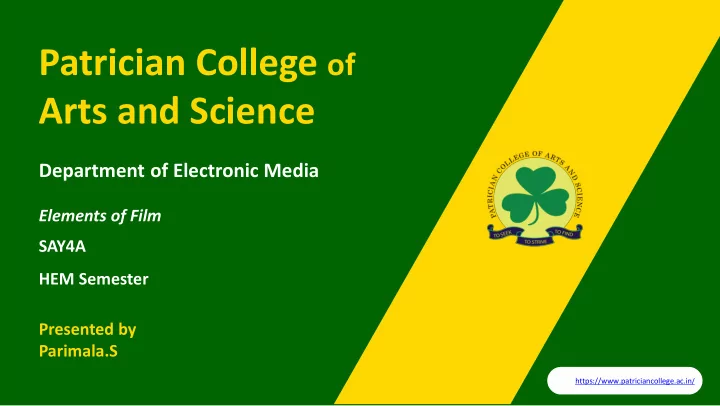

Patrician College of Arts and Science Department of Electronic Media Elements of Film SAY4A HEM Semester Presented by Parimala.S https://www.patriciancollege.ac.in /
1. German Expressionism Films. (1919 – 1950) • Expressionism began as a movement in art in Weimar, Germany during World War 1. • The movement affected many types of artistic medium including architecture, painting, music, literature and sculpture. Expressionist artists attempted to portray the disparity of their surroundings in artistic form. • Expressionism emerged simultaneously in various cities across Germany as a response to a widespread anxiety about man's increasingly discordant relationship with the world, his lost feelings of authenticity. • The “German style.” Emphasis on design or mise-en-scène, uncanny atmosphere, and composition (less on story and editing, unlike Hollywood).
• “The film image must become graphic art” (Hermann Warm). At the beginning of World War 1, foreign film companies dominated the industry. By the end of World War 1, the German Film Industry flourished. • Expressionism conveyed a tone of dissonance by effectively abolishing normal relationships between objects and focusing upon the abstract. Expressionist techniques aimed to conjure feelings of mystery, alienation. • Expressionism emerged simultaneously in various cities across Germany as a response to a widespread anxiety about man's increasingly discordant relationship with the world, his lost feelings of authenticity
• Plots incorporated dream sequences, flashbacks and distorted chronology to promote instability. • UFA produced many German Expressionist films which were destined to become classics. Many of the films, which achieved infamy outside of Germany, are still recognized and watched today. • Because of the deteriorating post-World War I economy in Germany, filmmakers were unable to create films which could compete with the grandiosity of Hollywood pictures
• German Expressionist films were made during the silent film era. They contained sounds and music as opposed to dialogue. • For many of the silent films, a piano player was hired to play as live accompaniment.
• (FILM STYLES OF GERMAN EXPRESSIONISM) Initially, highly symbolic and stylized non-realistic sets, sometimes geometric, filmed indoors. Distortion created by make- up, camera angles, costumes, strange sets, actors’ body language. • Dark human experiences – madness, betrayal, paranoia, obsession Subjective point of view (inner moods, feelings, perceptions) Moody Extreme camera angles, which often suggest being watched Repeated imagery of stairs, empty hallways and corridors.
• Harsh contrast of light and dark (chiaroscuro) reflect disturbed psyches and oppressive world Shadows and silhouettes express anxiety, uncertainty, and mental instability Structures cut horizontally and vertically to create stripes, angles and geometric forms Blurs boundary between reality and dreams Fatalism Voice-overs common. • Such Expressionist techniques aim to - abstract from realistic details and contingencies - bring out the “essence” of an object, situation, or state of being - express a subjective viewpoint - evoke mystery, alienation, disharmony, hallucination, dreams, extreme emotional states, destabilization.
French Impressionism Films.(1917 to 1930) • Also referred to as the first avant-garde or narrative avant-garde, is a term applied to a group of French films and filmmakers of the 1920s. • Hollywood imports dominated French film market and local production was in a crisis in the 1920s.
• Many French filmmakers worked for their own small production companies. A new generation of filmmakers explored the cinema as an art (impressionsim/avant- garde). • They were interested in pictorial beauty and psychology. Impressionism aims to capture the visual impression made by a scene (a movement in the 19th century).Beginning in 1918): made up of films that focus mainly on manipulation of the film as image, through camera work, mise-en- scene, and optical devices.
• (FILM STYLES OF FRENCH IMPRESSIONISM) • Key Points: • The impressionist films contain various visions, memories and dreams. • Filters used to affect the look of the images. • Superimpositions. • Reflecting surfaces like windows and mirrors. • Images out of focus. • Slow motion. • Camera movements. • Rapid editing (since 1923). • Realistic mise-en-scène.
Thank you https://www.patriciancollege.ac.in /
Recommend
More recommend